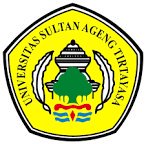PENGARUH PERBEDAAN SUHU ANTAR RAK BEDENGAN TERHADAP HASIL PRODUKSI DAN PENDAPATAN USAHATANI JAMUR MERANG (Volvariella volvaceae) DENGAN MEDIA KAPAS
Abstract
The purpose of this research are to analyze the effect of temperature’s difference on every rack to the weight of straw mushroom that will be produced and also to analyze the acceptance and income that will be earned by the mushroom’s farmer. The type of this research is quantitative research. The research is conduct at Kademangan Mushroom Farm, Setu, South Tangerang City. The selection of research sites is done purposively with the consideration that the selected location is the center of mushroom production in South Tangerang City. This study is conducted in March 2018 until April 2018. The sample that will be used in this research is thirty racks of shelf that filled with straw mushroom. Analysis of data used in this research is simple linear regression analysis, income analysis and RC Ratio. According to the research on the field, the best temperature for straw mushroom’s growth is ranged between 32,50C to 350C and the maximum production of straw mushroom is earned from shelf number 3 that located in the middle of the rack with 182 kg weight in one period of production. According to the analysis using simple linear regression analysis, the difference of temperatures between each rack has a significant effect to mushroom’s growth. And according to the acceptance and income analysis, the maximum income that is earned by shelf number 3 is Rp. 6.370.000 in one periode of production. The maximum income that is earned by the mushroom’s farmer is Rp. 17.535.000 and the total income that will be earned is Rp. 2698.014,00 with the value of the RC Ratio is 1,18 shows that straw mushroom cultivation business is efficient because RC Ratio value is more than one.
Keywords
Full Text:
PDFReferences
Achmad, dkk. 2011. Panduan Lengkap Jamur. Jakarta. Penebar Swadaya.
Amelia. 2017. Pengaruh Suhu dan Intensitas Cahaya Terhadap Pertumbuhan Jamur Tiram di Tangerang. Skripsi. Serang. Fakultas Pendidikan, Universitas Sultan Ageng Tirtayasa.
Agromedia.2009. Bertanam Jamur Konsumsi. Jakarta. PT. Agromedia.
Alex S. 2011. Untung Besar Budidaya Aneka Jamur. Yogyakarta. Pustaka Baru Press.
Direktorat Jenderal Hortikultura. 2006. Profil Jamur. Jakarta. Direktorat Jenderal Hortikultura.
Hanindita. 2006. Analisis Kelayakan Finansial Budidaya Jamur Merang pada usaha Agribisnis Putra Hasan Mushroom di Kecamatan Karang Bahagia, Bekasi, Jawa Barat. Skripsi. Bogor. Fakultas Ekonomi dan Manajemen, Institut Pertanian Bogor.
Hasan, Iqbal. 2004. Analisis Data Penelitian dengan Statistik. Jakarta. PT Bumi Aksara
Hernanto.F. 1989. Ilmu Usahatani. Jakarta. Penebar Swadaya.
Nasution PH. 2010. Analisis Usahatani Jamur Tiram Putih (Kasus di Komunitas Petani Jamur Ikhlas, Desa Cibening, Kecamatan Pamijahan, Kabupaten Bogor) [skripsi]. Bogor. Fakultas Ekonomi dan Manajemen, Institut Pertanian Bogor.
Piryadi TU. 2013. Bisnis Jamur Tiram. Jakarta (ID): AgroMedia Pustaka.
Sinaga, Meity. 2004. Jamur Merang dan Budidayanya. Penebar Swadaya. Jakarta.
Soeharjo, A dan Patong. 1973. Sendi – Sendi Pokok Usahatani. Jurusan Ilmu Sosial Ekonomi Pertanian. Institut Pertanian Bogor. Bogor
Soekartawi. 1986. Ilmu Usaha Tani dan Penelitian Untuk Pengembangan Petani Kecil. Universitas Indonesia (UI – Press). Jakarta.
Soekartawi. 1995. Analisis Usahatani. Universitas Indonesia (UI-Press). Jakarta.
Soekartawi. 2005. Agribisnis Teori dan Aplikasinya. Raja Grafindo Persada. Jakarta.
Tia Oktaviana. 2013. Analisis Pendapatan Usahatani dan Tataniaga Jamur Merang (Volvariella volvaceae) di Desa Gempol Kolot, Kecamatan Banyusari, Kabupaten Karawang. Bogor: Fakultas Ekonomi dan Manajemen, Institut Pertanian Bogor.
Utik Patmasari, dkk. 2007. Pengaruh Penambahan Zeolit Terhadap Viabilitas Bibit Jamur Merang. Jurnal, Fakultas Biologi. Universitas Gadjah Mada.
Yanuati, Indah. 2007. Kajian Perbedaan Komposisi Media Tanam Terhadap Pertumbuhan dan Hasil Jamur Merang. Skripsi, Fakultas Pertanian. Universitas Brawijaya.
DOI: http://dx.doi.org/10.33512/jat.v11i2.5098
Refbacks
- There are currently no refbacks.
Copyright (c) 2019 Fitri Hoerunnisa

This work is licensed under a Creative Commons Attribution-NonCommercial-ShareAlike 4.0 International License.
Editorial Office
Jurnal Agribisnis Terpadu
Jurusan Agribisnis Universitas Sultan Ageng Tirtayasa
Jl. Raya Palka KM. 03 Sindangsari, Kecamatan Pabuaran, Kabupaten Serang,
Provinsi Banten 42163 Telp. (0254) 3204321
Email: [email protected]






